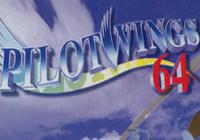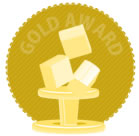Pilotwings 64 (Nintendo 64) Review
By Rudy Lavaux  16.06.2011
16.06.2011

When a new game console gets released, most manufacturers like to show off what the system is capable of through its launch games. Nintendo 64 was no exception, and probably one of the best examples of this. Pilotwings 64 was one of the titles that was revealed alongside the console at Shoshinkai in 1995, long before its much-delayed release, which happily left more time for the developers to polish their games. In the end, only three games were released alongside the system in PAL territories in 1997: the well-known Super Mario 64, Star Wars: Shadows of the Empire and Pilotwings 64, the sequel to the SNES launch classic. We're about to see how well the latter holds up today.
Like its predecessor, Pilotwings 64 has you flying all sorts of machinery, completing different mission objectives and landing the best you can, all this being subject to scoring. This time around, though, the progression structure is a bit different. At first, only three missions are available, one for each aircraft - hang glider, rocket belt and gyrocopter - which can be attempted in any order. Scoring a bronze badge, which corresponds to at least 70 out of 100 possible points, for each kind of aircraft unlocks the next level of difficulty (“class”). However, from there on, scoring a badge for a single vehicle allows the player to continue to the next class for that single vehicle, allowing it to freely keep on flying the same kind of aircraft until every mission for it has been completed.
From the second class of a total of four onwards, more than one mission with a certain type of aircraft must be played, and the total of all mission scores determines whether the player gets a badge or not, and thus whether the next class is unlocked or not. The missions themselves involve too many different kinds of objectives to cite, and are far more varied than in the SNES original. To name a few: shooting rockets at a giant evil robot with the gyrocopter, exploring narrow caves as quickly as possible with the rocket belt, or taking photos of a Loch Ness Monster-like creature as it pops out of the water while hang gliding.

Furthermore, managing to get good scores on the regular missions will unlock bonus extra games, such as the man-aiming cannon mini-game Cannonball, the Birdman suit and Jungle Hopper. All of them are completely unrealistic, especially compared to the rest of the game, but they're loads of fun nonetheless. Finally there's skydiving, which is now in the extras section, and not a regular type of mission anymore.
It's always possible to ignore the objectives to go and explore the environments. There's no free flight mode so to speak, except for the bird suit, but the amount of fuel available during the missions is always far more than enough to allow free exploration for quite some time. There are no time limits except for the amount of fuel left...and that's funny, because in some cases, like the hang glider, there are specific places in the environments that let the characters refill their fuel supply, such as a gas station lost in the Rocky Mountains of Little States Island, so it's possible to continue exploring indefinitely.
There are four islands in Pilotwings 64, all rather vast and varied. There's not much going on on them (though still more than in Pilotwings Resort), and not much either to actually ‘find’, but you can explore and appreciate the impressive level of detail (for the time) put into crafting villages, airports, amusement parks, parking lots, and much more, all contributing to a credible but not too realistic in-game world.

The Mount Rushmore with Mario's face replacing George Washington's, which turns into Wario's if you crash in it, is a good example of the universe Pilotwings 64 takes place in: surrealistic in all its Nintendo glory. The animation is a bit on the choppy side, as a result of the environments being sometimes incredibly crowded with details. Paradigm Simulation acknowledged that they used their own modeling software to make the environments for this game, which they normally used for making realistic flying simulations for the military, so that says a lot.
Sometimes the system, which was freshly released at the time and not fully mastered by the developers yet, has a hard time handling it all at once. When that happens, the frame rate takes a dive to 15 or so frames per second from an average of 20 to 25. This doesn't hinder the gameplay at all, but it's one of those annoying aspects of most Nintendo 64 games which fans of the system have learned to overlook over the years. It's just not as easy to bear by nowadays standards. Also worth noting is that, like most early Nintendo 64 games, the PAL version has two annoyingly thick black borders on top and bottom of the picture, a problem that plagued all PAL consoles in the past and started disappearing early in the Nintendo 64 life cycle.

Back on the topic of the missions, they offer a good level of challenge too. For example, for those familiar with the recent Pilotwings Resort, be warned that landing is judged far more severely here and getting a perfect score at landing is much harder in Pilotwings 64. More than often, the wind will make accurately aiming for the runway really difficult and obviously the shock between landing gears and a runway made of concrete and asphalt, if you're approaching too fast, can't be compared to the same thing happening between the bottom of a fuselage and water, so landing requires extra care here.
For the first and only time in the Pilotwings series, it's also possible to choose a pilot. There are six to choose from, divided into three weight categories, with a male and female choice for each weight. The influence their weight has only depends on what type of vehicle is being used. For example a light-weight character will make most hang gliding sessions easier because they take more altitude from using thermal currents, while heavy characters usually have bigger vehicles with more powerful propellers that give them a better max speed but with poor acceleration, a bit like in the Mario Kart series.
Of the three Pilotwings games made, Pilotwings 64 has the biggest simulation feel of the three, while still retaining the arcade style fun of the series and it's surrealistic aspect. Paradigm Simulation had never developed games before, only realistic simulations, so this doesn't come as a surprise. It was directed by Nintendo however, so it's still a very accessible game, but managing to get all perfect scores will require a lot of practice. More than in Pilotwings Resort, for comparison.

Cubed3 Rating
Exceptional - Gold Award

Despite the blurry Nintendo 64 video output not looking too good on modern TV sets, Pilotwings 64 is a game which, if you're into the genre, you will want to pop back into your console even all these years later. The fun missions, appealing environments, light-hearted music and varied objectives more than make up for the outdated graphics, and that's a staple of the best old-school classics, a category that Pilotwings 64 is certainly a part of. It helps too that it was designed by Shigeru Miyamoto himself and developed by specialists of simulations. A release on Virtual Console, which outputs games at higher resolution than on the original console, would suppress most frame rate issues that the original game had and remove the blur that the composite output and the N64 hardware itself added on top of the graphics. Finally, it would help bring this classic to the masses. It truly begs to be re-released - please make it happen Nintendo!

![]() 9/10
9/10
![]() 0
(0 Votes)
0
(0 Votes)
 Out now
Out now  Out now
Out now  Out now
Out now  Out now
Out now Comments
Comments are currently disabled

 Sign In
Sign In Game Details
Game Details Subscribe to this topic
Subscribe to this topic Features
Features






 Top
Top

